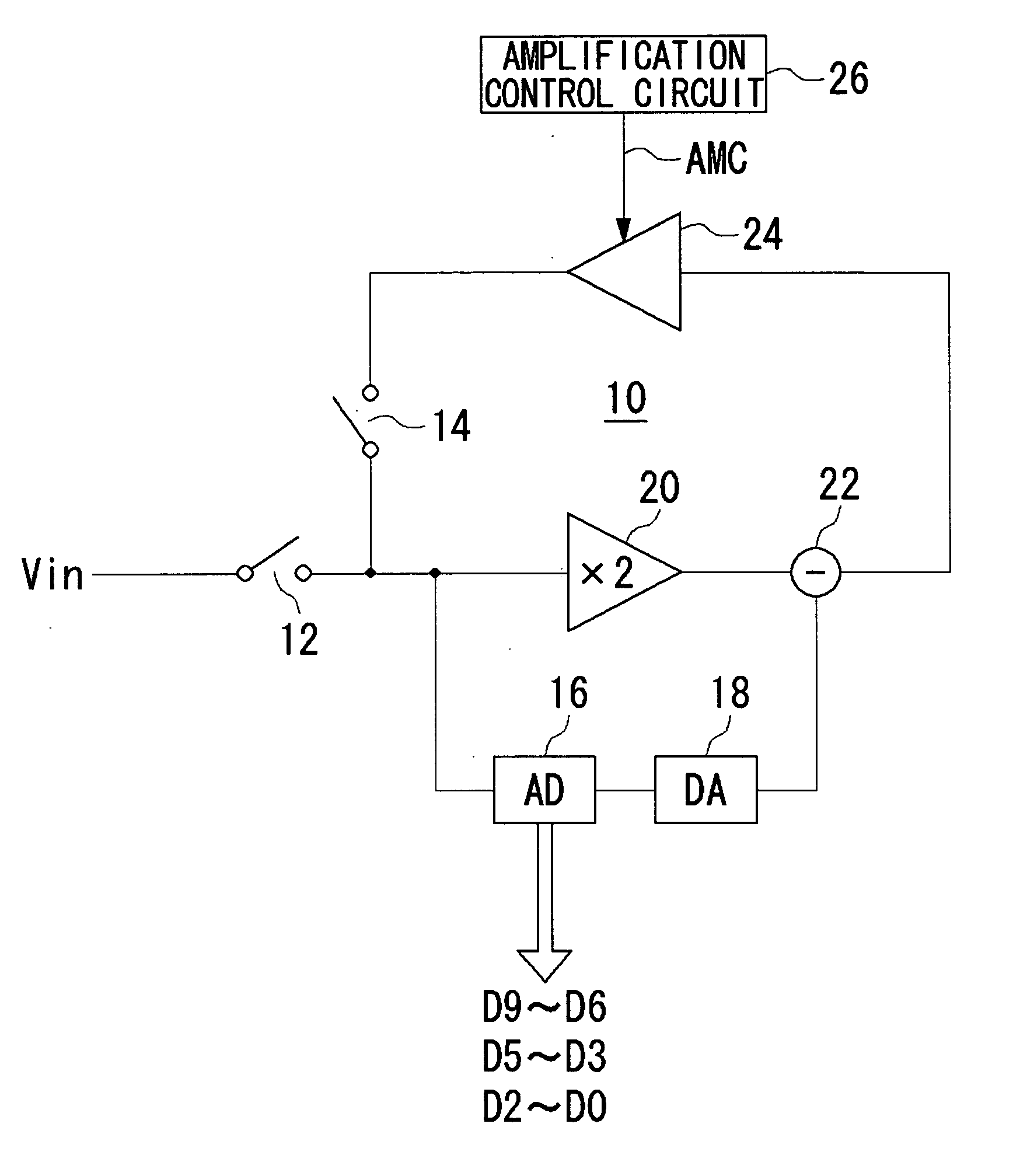Analog-to-digital converter having cyclic configuration
a technology of analog-to-digital converter and configuration, which is applied in the field of analog-to-digital converter technology of cyclic, can solve the problems of increasing power consumption, securing excessive conversion processing speed and conversion accuracy, and reducing the power consumption of ad converters, so as to reduce the power consumption and optimize the conversion accuracy
- Summary
- Abstract
- Description
- Claims
- Application Information
AI Technical Summary
Benefits of technology
Problems solved by technology
Method used
Image
Examples
first embodiment
[0105] In the present embodiment, the reference voltage range for generating reference voltages of the AD conversion circuit included in an AD converter of cyclic type is changed in accordance with the progress of the cyclic processing. Specifically, the reference voltage range mentioned above is reduced by half at the second and subsequent cycles. This makes it possible to suppress the gain of the amplifier circuit, allowing speedup of the entire AD converter.
[0106]FIG. 14 shows the configuration of the AD converter according to a first embodiment of the second group. In the AD converter, an input analog signal Vin is input to a first amplifier circuit 1011 and an AD conversion circuit 1012 through a first switch SW101. The AD conversion circuit 1012 converts the input analog signal into a maximum of four bits of digital value, and outputs the same to a not-shown encoder and a DA conversion circuit 1013. The DA conversion circuit 1013 converts the 4-bit maximum digital value outpu...
second embodiment
[0129] In the present embodiment, the first amplifier circuit is given a gain of 2 and the second amplifier circuit a gain of 2 while the amplifier circuit 1011 according to the first embodiment of the second group has a gain of 1 and the second amplifier circuit 1015 a gain of 4. This allows speedup further than in the first embodiment of the second group.
[0130]FIG. 20 shows the configuration of the AD converter according to the second embodiment of the second group. In the AD converter, an input analog signal Vin is input to a first amplifier circuit 1011 and an AD conversion circuit 1012 through a first switch SW101. The AD conversion circuit 1012 converts the input analog signal into a maximum of four bits of digital value, and outputs the same to a not-shown encoder and a DA conversion circuit 1013. The DA conversion circuit 1013 converts the 4-bit maximum digital value output from the AD conversion circuit 1012 into an analog signal.
[0131] The first amplifier circuit 1011 sa...
third embodiment
[0156] A third embodiment of the second group provides a cyclic AD converter having the configuration of changing the reference voltages of the AD conversion circuit 1012 and the gain of the first amplifier circuit 1011 as well.
[0157]FIG. 22a shows the configuration of the AD converter at its first cycle according to the third embodiment of the second group. FIG. 22b shows the configuration of the AD converter at the second and subsequent cycles according to the second embodiment of the second group. In the AD converter, an input analog signal Vin is input to a first amplifier circuit 1011 and an AD conversion circuit 1012 through a first switch SW101. The AD conversion circuit 1012 converts the input analog signal into a maximum of four bits of digital value, and outputs the same to a not-shown encoder and a DA conversion circuit 1013. The DA conversion circuit 1013 converts the 4-bit maximum digital value output from the AD conversion circuit 1012 into an analog signal.
[0158] Th...
PUM
 Login to View More
Login to View More Abstract
Description
Claims
Application Information
 Login to View More
Login to View More - R&D
- Intellectual Property
- Life Sciences
- Materials
- Tech Scout
- Unparalleled Data Quality
- Higher Quality Content
- 60% Fewer Hallucinations
Browse by: Latest US Patents, China's latest patents, Technical Efficacy Thesaurus, Application Domain, Technology Topic, Popular Technical Reports.
© 2025 PatSnap. All rights reserved.Legal|Privacy policy|Modern Slavery Act Transparency Statement|Sitemap|About US| Contact US: help@patsnap.com



